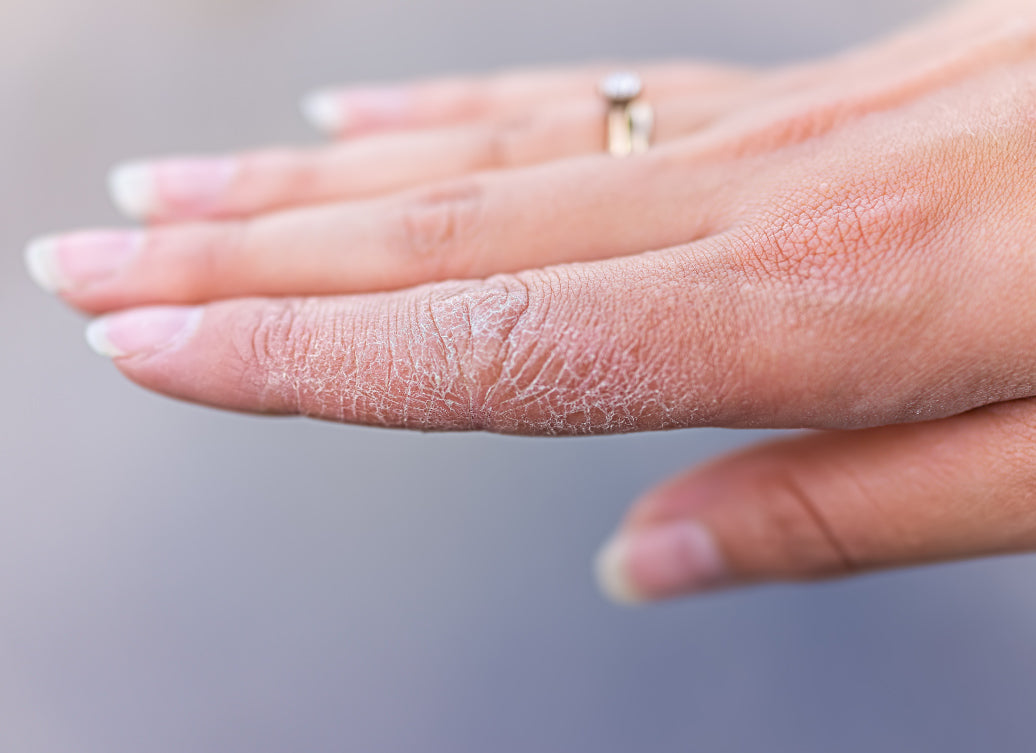Dyshidrosis is a particularly persistent and uncomfortable type of eczema; in this blog we look at the most efficient way to get rid of the condition!
What is dyshidrosis?
Dyshidrosis is a type of dermatitis, also known as pompholyx, dyshidrotic eczema, vesicular hand dermatitis or acute palmoplantar eczema. Like other types of dermatitis or eczema, it can be a persistent problem, with flares of the condition coming and going over a long period of time. Affected skin on fingers and toes can be intensely itchy, or feel burning or stinging. Dyshidrosis generally affects the fingers and toes, although it can spread to palms and soles of the feet. In severe cases, the dyshidrosis can be much more widespread and affect the backs of hands and feet. However, most mild cases can be managed at home.
What does dyshidrosis feel like?
Dyshidrosis tends to start with just the sensation of burning and itchiness, but goes on to cycle through various stages. The skin breaks into tiny, fluid-filled blisters, and as the blisters increase in size, the skin can start weeping. It then moves on to a drying stage where the blisters dry out and can crack, causing patches of very sore dry skin. The last stage is when the skin heals up.
What does dyshidrosis look like?
The condition can look very different in its different stages. At first, when it’s just itchy, you may not notice anything obvious about the skin; it’s usually the little bubbles of fluid under the skin that alerts doctors or pharmacists to the possibility that it might be dyshidrosis. As the flare progresses and the blisters break open, skin can look very raw and inflamed. Sometimes the skin gets infected, so added to the blisters are signs of oozing pus and crusting over.
What causes dyshidrosis?
It can be hard to pinpoint the root cause of dyshidrosis; certainly some people seem more prone to it than others, so there’s probably a genetic factor involved. A flare is usually triggered by something specific, and if you’re still being affected by whatever it was, the condition can be very hard to shift.
Possible triggers include:
- Irritant substances (ie something your skin has come into contact with such as soap, sanitiser, washes, detergents, household or industrial chemicals)
- Stress
- Water (prolonged contact with water can aggravate dyshidrosis)
- Heat and humidity
- Sweating
- Fungal infections
How can you get rid of dyshidrosis?
Unfortunately, dyshidrosis is not something that can be cured outright.
In fact, in most cases, a flare of dyshidrosis will resolve itself in time, cycling through the stages and eventually healing up by itself. This is likely to take longer if your skin is still affected by whatever triggered the flare, so managing the condition is mostly about taking steps to help your skin heal, and managing the symptoms so you feel more comfortable during the process. Itching and scratching at intensely itchy skin can damage it further and lead to infections.
It’s a good idea to take the following steps to get on top of a mild case of dyshidrosis:
- Identify and avoid whatever triggered the flare
- Soothe the itch with cold compresses or anti-itch products
- Keep skin dry and protected (thin cotton gloves can help)
- Keep drying or cracked skin hydrated with intensive emollients
- Avoid infection by keeping skin clean with a gentle soap-free wash
- Keep skin in good condition long-term with nourishing emollients
A pharmacist could also help, by advising on antihistamines, antiseptic solutions for bathing hands or feet. If your dyshidrosis doesn’t improve within a week with these measures at home, gets worse, or you suspect infection, consult a doctor. There are options for medical treatment which include phototherapy, topical steroids and immunosuppressants.
Recommended products for skin prone to dyshidrosis:
Balmonds Skin Salvation
(for the dry, cracked stages)
Balmonds Cooling Cream
(for itchy stage)
Balmonds Natural Shampoo & Body Wash
(to use instead of soap)
Balmonds Scalp Oil
(for clean, nourished skin)
